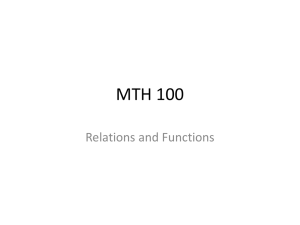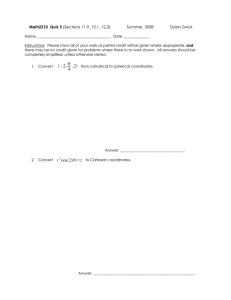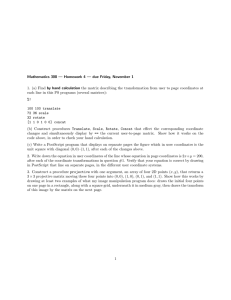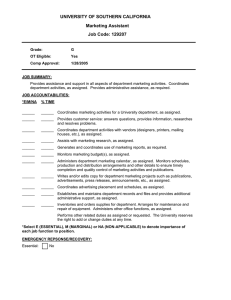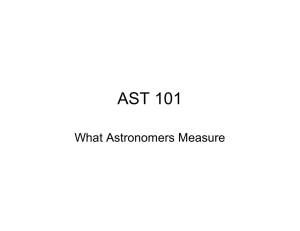Document 13136828
advertisement
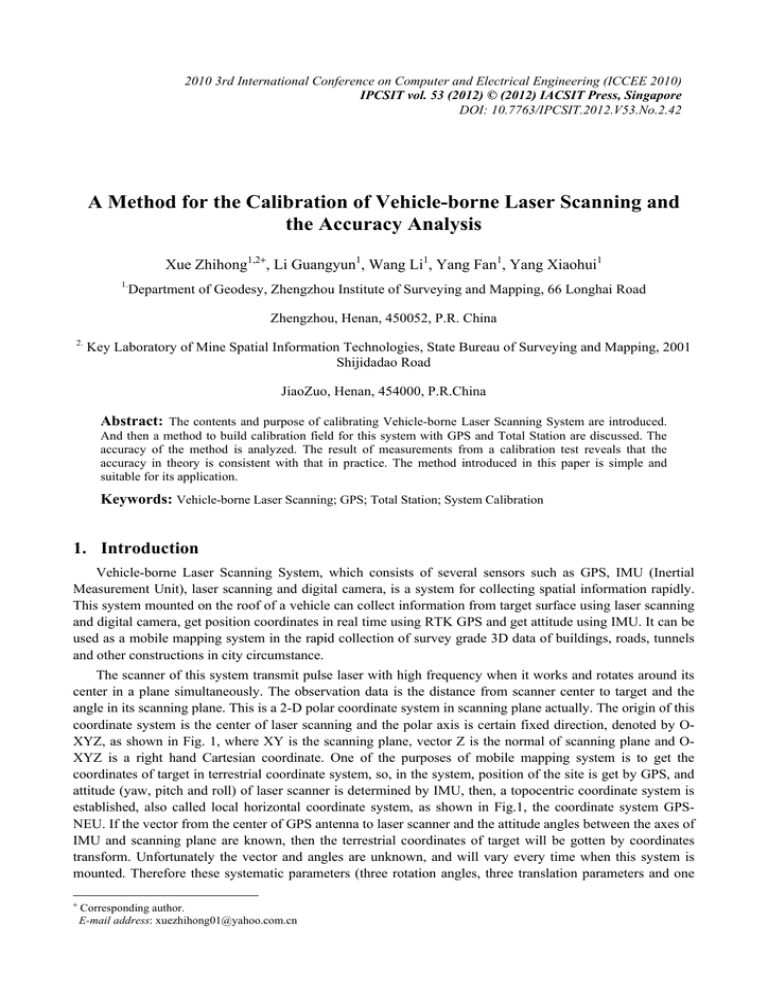
2010 3rd International Conference on Computer and Electrical Engineering (ICCEE 2010) IPCSIT vol. 53 (2012) © (2012) IACSIT Press, Singapore DOI: 10.7763/IPCSIT.2012.V53.No.2.42 A Method for the Calibration of Vehicle-borne Laser Scanning and the Accuracy Analysis Xue Zhihong1,2+, Li Guangyun1, Wang Li1, Yang Fan1, Yang Xiaohui1 1. Department of Geodesy, Zhengzhou Institute of Surveying and Mapping, 66 Longhai Road Zhengzhou, Henan, 450052, P.R. China 2. Key Laboratory of Mine Spatial Information Technologies, State Bureau of Surveying and Mapping, 2001 Shijidadao Road JiaoZuo, Henan, 454000, P.R.China Abstract: The contents and purpose of calibrating Vehicle-borne Laser Scanning System are introduced. And then a method to build calibration field for this system with GPS and Total Station are discussed. The accuracy of the method is analyzed. The result of measurements from a calibration test reveals that the accuracy in theory is consistent with that in practice. The method introduced in this paper is simple and suitable for its application. Keywords: Vehicle-borne Laser Scanning; GPS; Total Station; System Calibration 1. Introduction Vehicle-borne Laser Scanning System, which consists of several sensors such as GPS, IMU (Inertial Measurement Unit), laser scanning and digital camera, is a system for collecting spatial information rapidly. This system mounted on the roof of a vehicle can collect information from target surface using laser scanning and digital camera, get position coordinates in real time using RTK GPS and get attitude using IMU. It can be used as a mobile mapping system in the rapid collection of survey grade 3D data of buildings, roads, tunnels and other constructions in city circumstance. The scanner of this system transmit pulse laser with high frequency when it works and rotates around its center in a plane simultaneously. The observation data is the distance from scanner center to target and the angle in its scanning plane. This is a 2-D polar coordinate system in scanning plane actually. The origin of this coordinate system is the center of laser scanning and the polar axis is certain fixed direction, denoted by OXYZ, as shown in Fig. 1, where XY is the scanning plane, vector Z is the normal of scanning plane and OXYZ is a right hand Cartesian coordinate. One of the purposes of mobile mapping system is to get the coordinates of target in terrestrial coordinate system, so, in the system, position of the site is get by GPS, and attitude (yaw, pitch and roll) of laser scanner is determined by IMU, then, a topocentric coordinate system is established, also called local horizontal coordinate system, as shown in Fig.1, the coordinate system GPSNEU. If the vector from the center of GPS antenna to laser scanner and the attitude angles between the axes of IMU and scanning plane are known, then the terrestrial coordinates of target will be gotten by coordinates transform. Unfortunately the vector and angles are unknown, and will vary every time when this system is mounted. Therefore these systematic parameters (three rotation angles, three translation parameters and one + Corresponding author. E-mail address: xuezhihong01@yahoo.com.cn scale factor) should be determined, namely external parameters calibration for vehicle-borne laser scanning system. Fig.1. The coordinates of laser mobile mapping system The currently method is: selecting a number of characteristic points in a suitable field and getting there coordinates belonging to terrestrial coordinate system in advance , these characteristic points act as common points. And then getting there coordinates using laser scanner, the seven parameters of BURSA-WOLF transformation model will be obtained by the method of least squares adjustment at last. A method for measuring those common points using GPS and Total Station is presented in this study. The data demonstrated below are taken from acceptance check for a vehicle-borne laser scanner. 2. The calibration field and characteristic point Calibration is necessary before acceptance check for a product of vehicle-borne laser scanning system. According to the specification and conditions in the calibration field, some common points are chosen. These points can be classified into two groups. One is located uniformly on the ground before a building; the other is located on the wall of the building. Marking on the wall is not allowed, so, window corners of second and third floor are chosen as common points, as shown in Fig 2. There are about 100 points chosen on the wall. The white circles in the picture upstairs denote the position of window corners, which is the target aimed at by reflectorless Total Station. An enlarged picture is shown on the picture downstairs in Fig.2. Fig.2. The characteristic points on the wall Upstairs: layout of some characteristic points, denoted by white circle in picture Downstairs: one point on corner of a window, where aimed at by total station 3. Schemes It is about 250m along the east-west direction of the calibration field and 160m along the south-north, see Fig.3. The point P1 is selected as datum point on account of GPS constellation visibility. The horizontal accuracy of common points should be better than 20mm and 30mm vertically relative to the datum point according to the specification. So, GPS RTK (Real Time Kinematic) survey technique is suitable for common points on the ground, but for those points on the wall reflectorless Total Station had to be used. Control points are needed when Total Station is set up. Taking the condition of this calibration field into account, the control networks were divided into two orders, i.e. the primary network and secondary network. The primary network consists of 3 control points: p1, p4 and p7. Every baseline in the triangle was measured using GPS static survey mode for 30 minutes with sampling interval 10 seconds and the elevation cut-off angle 15°. Then all baseline observations were processed and the network was adjusted with free network adjustment. The accuracy of points in primary network is about 3mm. The secondary network consists of 11 control points, denoted by circle as shown in Fig 3. The location of those points should be suitable for data collection for GPS as well as for Total Station. So, it should be inter- visible between adjacent control points. These points were measured using GPS RTK technique and the base station is set on control point P1. Control point P4 and P7 in primary network are measured using GPS RTK too for checking the accuracy of RTK survey. Control points in primary and secondary networks are marked using steel nail with crossing lines on the head. The diameter of crossing center is less then 0.5mm. The common points on the wall are measured using reflectorless Total Station. Before every sides of the building there was set two stations, left station and right station, for the reason of accuracy. There are 8 station sites, which are P10, P9, P8, P7, P6, P5, P4 and P3.On each station the Total Station measures only those points on the right or left half of the opposite wall in case of bad accuracy due to long range or big angle of incidence. The maximal range from control points to common points on the wall is 43m among all observations. The most vertical angle is less then 8 degree except for very few to 17 degree. Big vertical angles are among observations of station on the east of the building. Because another building are close to the east of our building and the narrow space between the two buildings lead to big vertical angle. P11 P2 N P4 P3 P1 P5 P10 The building in the calibration field P12 P9 P6 P8 P7 P14 P13 Fig.3. Calibration field and control points 4. Measurement in topocentric coordinate system The geodetic coordinates or Cartesian coordinates of every point are provided in WGS84 reference system. While plane coordinates are needed for Total Station sets up. Usual conversion method is projection such as Gauss- Kueger firstly, and then setting up Total Station upon a control point, plane coordinates of common points can be measured. Inverse solution of projection is performed to turn back geodetic coordinates at last. Both because of the complication of the algorithm and because of extra systematic error due to direct solution and inverse solution of projection, another simple algorithm is presented in this paper. That is: data collection and processing is performed in topocentric coordinate system firstly and then transition is carried out to obtain geodetic coordinates of target points. Fig.4. measurement in topocentric coordinate system The relationship between topocentric coordinate system and geodetic coordinate system is shown in Fig.4 (a). Where A is the origin of topocentric coordinate system with geodetic coordinates ( B0 , L0 , H 0 ) and Cartesian coordinates ( X 0 , Y0 , Z 0 ) . For any point whose coordinates in the geodetic and topocentric coordinate system are ( X , Y , Z ) and ( N , E ,U ) , respectively, one has relation given by (1) ⎛ ⎡X ⎤ ⎡X0 ⎤⎞ ⎡N ⎤ ⎢ E ⎥ = T ⋅⎜ ⎢Y ⎥ − ⎢ Y ⎥ ⎟ ⎜⎢ ⎥ ⎢ 0 ⎥⎟ ⎢ ⎥ ⎜⎢Z ⎥ ⎢Z ⎥⎟ ⎢⎣U ⎥⎦ ⎝⎣ ⎦ ⎣ 0 ⎦⎠ (1) where: ⎡ − sin B0 cos L0 T = ⎢⎢ − sin L0 ⎢⎣ cos B0 cos L0 − sin B0 sin L0 cos L0 cos B0 sin L0 cos B0 ⎤ 0 ⎥⎥ sin B0 ⎥⎦ (2) In small area the deflection of the vertical and surface bend of the earth can be omitted. That’s mean the normal line of reference ellipsoid and the plump line of the gravitational field coincide as well as the surface of the earth is treated as plane. Then a topocentric coordinate system is defined as shown in Fig. 4(b). The origin of the local horizontal coordinate system is the site of the Total Station denoted by A. And B in the Fig. 4(b) is another known orientation control point. P is an unknown point. α 0 denotes known coordinate azimuth JJJG of AB . And α , β , s denotes horizontal angle, vertical angle and distance respectively to be measured using Total Station. hA is instrument height. Then the coordinates of point P in topocentric coordinate system is given by (3). N = s ⋅ cos(α 0 + α ) (3) E = s ⋅ sin(α 0 + α ) U = hA + s ⋅ sin β The coordinates in geodetic coordinate system can be obtained with inverse transition of (1). 5. The accuracy assessment and the result The error sources of common point coordinates include: the coordinates error of control points, height error of instrument, the errors of horizontal angle, vertical angle and distance. Then the error of common point coordinates can be derived from (3) by error propagation theorem. Let the coordinates error of station site lie over then one gets (4): mN2 = (cos(α 0 + α ) ⋅ ms ) 2 + ( s ⋅ sin(α 0 + α ) ⋅ mα0 ) 2 + ( s ⋅ sin(α 0 + α ) ⋅ mα ) 2 mE2 = (sin(α 0 + α ) ⋅ ms ) 2 + ( s ⋅ cos(α 0 + α ) ⋅ mα0 ) 2 + ( s ⋅ cos(α 0 + α ) ⋅ mα ) 2 (4) mU2 = mh2A + (sin β ⋅ ms ) 2 + ( s ⋅ cos β ⋅ mβ ) 2 In (4), mα 0 is described by N E mα20 = ( 2 B 2 mEB ) 2 + ( 2 B 2 mN B ) 2 N B + EB N B + EB (5) mEB and mN B are assumed equal and rewritten as mB , then (5) turn out to be (6): mα0 = mB / S B (6) where S B is the distance from station site A to orientation control point B. So, orientation control point should be selected as far as possible from the station site for the sake of smaller mα 0 . Let mB = 10mm , mα = 5′′ , mβ = 5′′ , ms = 10mm , mh = 5mm , β =20 ° , s = 50m , S B = 200m , then the horizontal accuracy is 10mm and vertical accuracy is 6mm according to (4) and (6). Now taking coordinates error of control points into account, it is a translation effect. Let assume the horizontal accuracy of station site is 10mm and vertical accuracy is 20mm, and then the accuracy of common points meet the demands as well. It’s has to be reminded that the assumption above is derived from bad conditions. A All common points in the calibration field were measured using Total Station Leica TRC402 according to the method presented above. Some control points were measured using Total Station also for the sake of accuracy assessment. The coordinates of those control points derived from Total Station and RTK were compared. The difference is shown in tableⅠ. TABLE I. THE RESULT OF CHECKED POINTS Check-up dN(m) dE(m) dU(m) Station:P10,op: P1,check: P2 Station:P9,op:P1, check: P2 0.003 -0.022 0.000 0.020 0.000 0.006 Station:P8,op:P14, check: P13 -0.031 0.000 0.013 Station:P4,op:P11, check: P5 Station:P3,op:P2, check: P4 -0.017 0.019 0.023 0.000 -0.016 -0.010 Station: the site where Total Station was set up Op: orientation control point used for total station set up Check: the point used for check-up. Taking for the tolerance as twice mean square error, then the tolerance in horizontal is 40mm and vertical is 60mm. Every item in table Ⅰis satisfied. Some common points were measured twice respectively from adjacent station sites. Then there coordinates respectively derived from different station sits can be compared. Part comparison are listed in table Ⅱ. Taking for the tolerance as twice mean square error still, then the tolerance in horizontal is 56mm and vertical is 84mm. Every item in table Ⅱ is satisfied. TABLE II. COMPARISON RESULT Coincidence point: S2-15 B(°′″) L(°′″) H(m) Station :P8, Op:P14 ** ** 38.3491 *** ** 08.0400 47.920 Station :P7, Op:P14 ** ** 38.3487 *** ** 08.0410 47.906 difference(m) 0.013 -0.024 0.014 Coincidence point: N2-14 B(°′″) L(°′″) H(m) Station :P4, Op:P11 ** ** 40.7828 *** ** 06.2560 47.922 Station :P3, Op:P2 ** ** 40.7837 *** ** 06.2560 47.922 difference(m) -0.028 0.000 0.000 Cincidence point: P12 B(°′″) L(°′″) H(m) Station :P6, Op:P7 ** ** 40.6275 *** ** 09.7540 44.478 Station :P5, Op:P6 ** ** 40.6266 *** ** 09.7550 44.469 difference(m) 0.028 -0.023 0.009 Station: the site where Total Station was set up Op: orientation control point used for total station set up Parts of these common points are used for calibration of certain Vehicle-borne Laser Scanning, and then others are used for check-up. The result of comparison is listed in table Ⅲ. TABLE III. RESULT OF COMPARISON BETWEEN COORDINATES DERIVED FROM DIFFERENT WAY (UNIT IN TABLE: m ) Point Number Coordinates from laser scaner East North 1 **4637.43 **25573.49 2 **4638.94 **25569.84 3 **4641.26 4 **4642.78 5 6 Height Coordinates from Total Station East North 49.56 **4637.44 **25573.49 49.61 **4638.96 **25569.80 **25564.20 49.55 **4641.25 **25560.61 49.64 **4642.78 **4644.26 **25556.89 49.59 **4647.33 **25549.49 49.55 7 **4648.86 **25545.80 8 **4658.00 **25523.68 Height Difference DE DN Du 49.60 -0.01 0.00 -0.04 49.60 -0.02 0.04 0.01 **25564.21 49.59 0.01 -0.01 -0.04 **25560.59 49.59 0.00 0.02 0.05 **4644.28 **25556.87 49.60 -0.02 0.02 -0.01 **4647.36 **25549.48 49.59 -0.03 0.01 -0.04 49.55 **4648.87 **25545.79 49.59 -0.01 0.01 -0.04 49.61 **4657.98 **25523.67 49.59 0.02 0.01 0.02 9 **4659.54 **25519.94 49.62 **4659.50 **25519.93 49.59 0.04 0.01 0.03 10 **4661.05 **25516.25 49.62 **4661.03 **25516.24 49.59 0.02 0.01 0.03 11 **4662.57 **25512.55 49.55 **4662.56 **25512.55 49.59 0.01 0.00 -0.04 12 **4664.08 **25508.88 49.54 **4664.09 **25508.86 49.56 -0.01 0.02 -0.02 13 **4667.93 **25499.58 49.55 **4667.90 **25499.62 49.58 0.03 -0.04 -0.03 14 **4638.01 **25571.88 47.87 **4638.03 **25571.86 47.90 -0.02 0.02 -0.03 15 **4639.53 **25568.16 47.88 **4639.54 **25568.16 47.90 -0.01 0.00 -0.02 16 **4641.84 **25562.65 47.90 **4641.83 **25562.66 47.90 0.01 -0.01 0.00 17 **4643.35 **25558.92 47.91 **4643.36 **25558.91 47.90 -0.01 0.01 0.01 18 **4644.88 **25555.21 47.88 **4644.89 **25555.22 47.89 -0.01 -0.01 -0.01 19 **4646.40 **25551.52 47.89 **4646.41 **25551.53 47.90 -0.01 -0.01 -0.01 20 **4647.95 **25547.80 47.88 **4647.93 **25547.84 47.89 0.02 -0.04 -0.01 21 **4657.07 **25525.69 47.87 **4657.04 **25525.67 47.88 0.03 0.02 -0.01 Twenty one points are selected for check-up. Then there coordinates are compared with that derived from certain Vehicle-borne Laser Scanning. The maximal difference is 4cm and standard deviation is 2cm in horizontal. In vertical that is 4cm and 3cm respectively. These meet the specification. 6. Conclusions Nowadays, it shows grate advantages that the Vehicle-borne mapping system is being popularized. The method presented in this paper which used for building calibration field for Vehicle-borne Laser Scanning with GPS and TPS based in topocentric coordinate system is simply but rigorous in theory. This method can meet the demands of specification. It is still necessary to give some explanation that higher accuracy of this method can be achieved by further improvement. For example, GPS static survey mode instead of RTK and Total Station with more precision instead of TC402 can be adopted in this method. 7. Acknowledgment This paper is funded by Key Laboratory of Mine Spatial Information Technologies (Henan Polytechnic University, Henan Bureau of Surveying & Mapping), State Bureau of Surveying & Mapping( No.KLM201009). 8. References [1] Li Shukai,Liu Shaochuang,1999,Progress in Mobile Airborne Laser-Ranging Multispectral Imaging Mapping System, Journal of Image and Graphics, Vol.l4,No.2,pp.89-94. [2] Kang Yongwei, Zhong Ruofei, Wu Yu, 2008, Research of calibrating vehicle laser scanner’s external parameters, Infrared and Laser Engineering, Vol.37, Supplement ,pp249-253. [3] Li Yongqiang, Sheng Yehua, Liu Huiyun, Zhang Ka, Dai Huayang, 2008,3D Road Information Extraction Based on Vehicle-borne Laser Scanning, Science of Surveying and Mapping, Vo1.33, No.4,pp.24-25. [4] Xu QiFeng, 2001, Space Geodesy, China: publishing company of PLA. [5] Lu Zhiping, Zhang Jianjun, Qiao Shubo, 2005, Foundation of Geodesy, China: publishing company of PLA. [6] Sui Lifen, Song Lijie, 2004, Error Theory and Foundation of Surveying Adjustment, China: publishing company of PLA.
